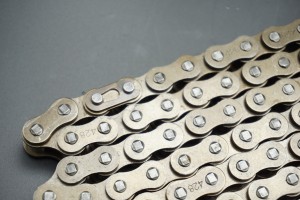Roller chains are an essential component in many industrial applications, from heavy machinery to bicycles. Their key purpose is to transfer power from one moving part to another. However, knowing the size and measurements of roller chains can be quite difficult for many people. In this blog post, we will delve into the world of roller chain measurement, exploring the various key dimensions and factors that determine its size. Finally, you’ll have a clearer understanding of how to measure roller chain.
1. ANSI standard for roller chains:
The American National Standards Institute (ANSI) has developed standards for classifying roller chains based on their pitch (the distance between the centers of the individual rollers). The pitch size determines the strength of the chain and its compatibility with sprockets and other components.
2. Pitch size and roller diameter:
Roller chains are primarily measured by pitch dimensions. This refers to the distance between the centers of adjacent rollers. Standard pitch sizes range from 0.375 inches to 3 inches or more. Note that pitch dimensions do not include roller diameter.
3. Roller chain and transmission system size:
Roller chain dimensions are inherently related to specific drive system requirements. Factors such as horsepower, speed, and torque play a vital role in choosing the proper chain size. Higher horsepower applications often require larger pitch sizes for increased strength and reduced wear.
4. Roller chain standard:
Roller chains are designed and manufactured to specific industry standards. These standards ensure consistency in chain size, material and overall performance. The most common roller chain standards include ANSI, ISO and DIN. It is important to adhere to these criteria when selecting a roller chain for your application.
5. Breaking load and ultimate strength:
The breaking load and ultimate strength of a roller chain indicate its maximum load carrying capacity. These indicators relate to the pitch size of the chain and the materials used in its construction. Manufacturers provide breaking load and ultimate strength values for different chain sizes, enabling users to select a chain that meets their specific load requirements.
6. Roller chain extensions:
The length of the chain can be extended or shortened to suit various applications. Roller chains are extended by adding or removing links. When extending a chain, it is critical to maintain proper tension and ensure the chain conforms to the desired pitch size.
7. Lubrication and maintenance:
Proper lubrication and regular maintenance are essential to ensure the long life and reliable performance of your roller chain. Regular lubrication helps reduce friction, wear and corrosion. Follow the manufacturer’s recommendations for lubrication intervals and the type of lubricant used.
Roller chains are measured in pitch dimensions, which determine their compatibility and strength. Understanding the dimensions, standards and factors of roller chain measurement is critical to selecting the proper chain for your specific application. By adhering to established standards, considering load requirements and ensuring proper lubrication and maintenance, you can maximize the efficiency, reliability and service life of your roller chain. Remember that roller chains are not just mechanical components, but critical links in the smooth operation of various industrial systems.
Post time: Jul-10-2023

